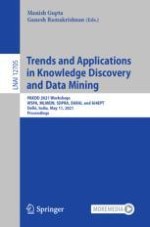This book constitutes the refereed proceedings of five workshops that were held in conjunction with the 25th Pacific-Asia Conference on Knowledge Discovery and Data Mining, PAKDD 2021, in Delhi, India, in May 2021.
The 17 revised full papers presented were carefully reviewed and selected from a total of 39 submissions..
The five workshops were as follows:
Workshop on Smart and Precise Agriculture (WSPA 2021)
PAKDD 2021 Workshop on Machine Learning for Measurement Informatics (MLMEIN 2021)
The First Workshop and Shared Task on Scope Detection of the Peer Review Articles (SDPRA 2021)
The First International Workshop on Data Assessment and Readiness for AI (DARAI 2021)
The First International Workshop on Artificial Intelligence for Enterprise Process Transformation (AI4EPT 2021)
